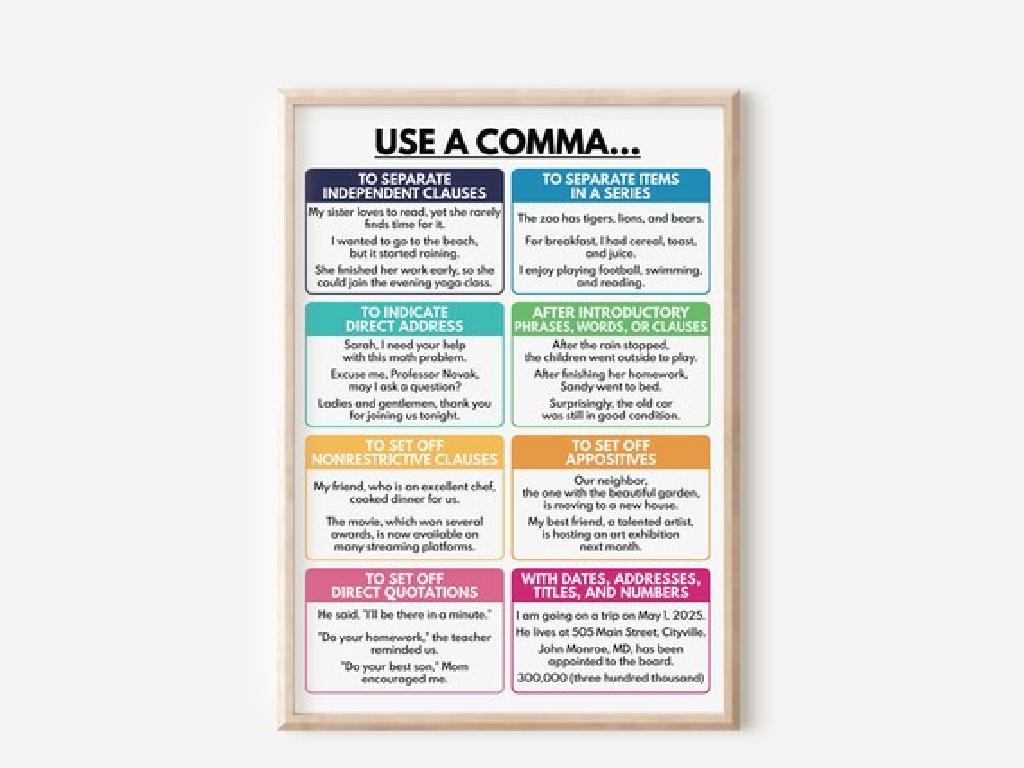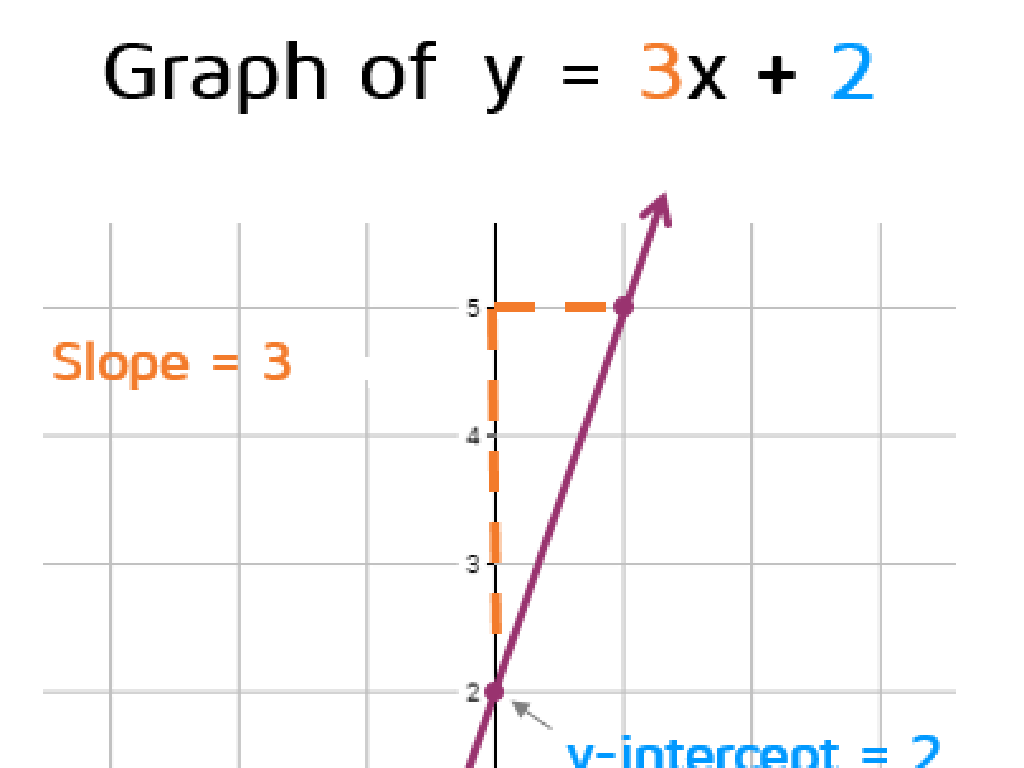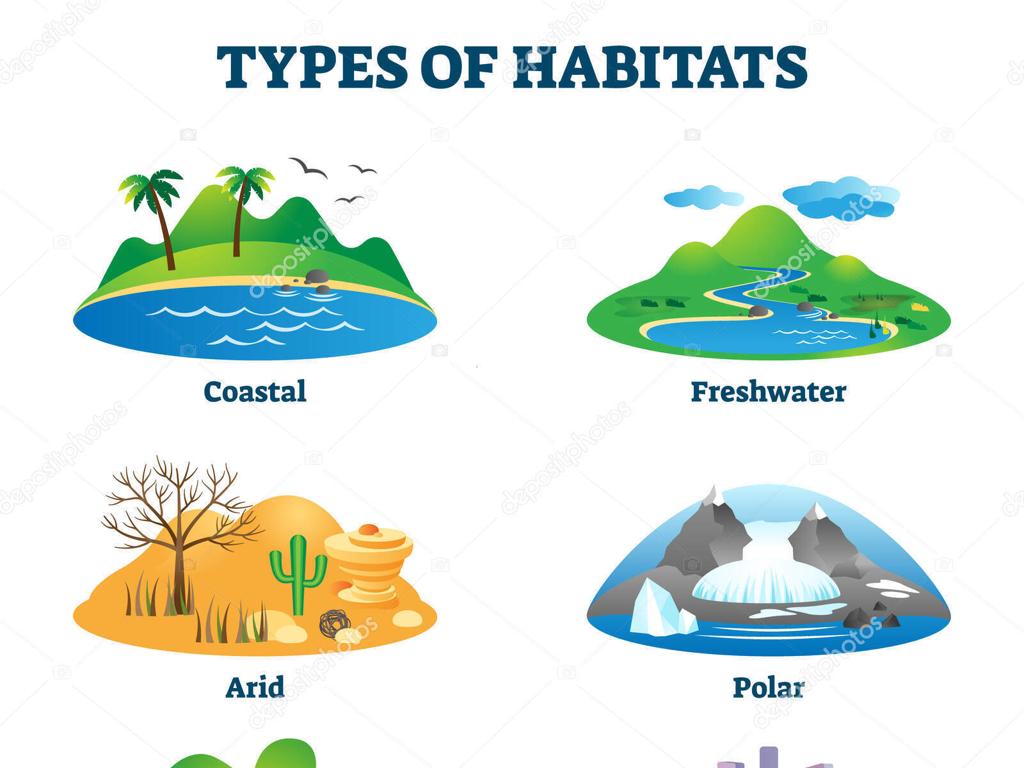Read Sight Words Set 9: Came, Going, Say, Too, With
Subject: Language arts
Grade: Kindergarten
Topic: Sight Words
Please LOG IN to download the presentation. Access is available to registered users only.
View More Content
Welcome to Sight Words!
– Sight words are common words
– They help us read smoothly
– Today’s words: came, going, say, too, with
– ‘came’ as in ‘She came to the party’, ‘going’ as in ‘We are going to the zoo’
– Practice makes perfect
– Use the words in sentences at home
|
This slide introduces kindergarteners to the concept of sight words, which are frequently used words that young readers should recognize instantly. Emphasize the importance of these words in achieving reading fluency. Introduce each of the five new sight words by saying them out loud and using them in simple sentences. Encourage the children to repeat the words after you. Plan activities where students can practice these words in class, such as matching games, flashcards, or writing them in sentences. For homework, ask the students to practice reading these words with their family members and use them in sentences to reinforce their learning.
Sight Words Set 9: Learning to Read with Ease
– What are sight words?
– Words we often see and should quickly recognize
– Sight words are frequent flyers
– Words like ‘came’, ‘going’, ‘say’, ‘too’, ‘with’ appear often in texts
– Some words don’t follow the rules
– Unlike ‘cat’ or ‘dog’, these words may not sound like they look
– Recognizing sight words = smoother reading
– Knowing sight words helps us read stories more fluently
|
This slide introduces the concept of sight words to Kindergarten students, emphasizing their importance in developing reading fluency. Sight words are common words that appear frequently in text and are best learned through memorization, as they often don’t adhere to standard phonetic rules. By recognizing these words on sight, young readers can navigate sentences more smoothly, without having to stop and decode each word. This leads to better comprehension and enjoyment of reading. Encourage students to practice these words at home and in class to build their reading confidence.
Sight Word Practice: ‘came’
– Spelling of ‘came’: C-A-M-E
– Pronunciation practice: ‘came’
– Create a sentence with ‘came’
– Example: ‘The cat came to cuddle.’
– Group activity: Share sentences
– Encourage sharing and listening.
|
This slide focuses on the sight word ‘came’. Start by spelling the word out loud, letter by letter, while pointing to each letter to help students visualize and memorize the spelling. Next, practice saying the word ‘came’ together to ensure correct pronunciation. Then, challenge the students to create their own sentences using the word ‘came’. Provide an example to guide them. Finally, organize a group activity where students can share their sentences with the class. This encourages participation and helps students learn from each other. It’s also an opportunity to correct any misunderstandings and reinforce the correct usage of the word ‘came’ in a sentence.
Learning the Sight Word: ‘going’
– Spelling of ‘going’: G-O-I-N-G
– Pronunciation: Let’s say ‘going’ together
– Usage in a sentence: Who can try?
– Example: I am going to the park.
– Practice: Find ‘going’ in a book
– Spot the word ‘going’ during reading time.
|
This slide focuses on the sight word ‘going’. Start by spelling the word out loud, letter by letter, while pointing to each letter. Have the class repeat the spelling and pronunciation of ‘going’ after you. Encourage students to come up with their own sentences using ‘going’, which will help them understand the word’s usage in context. As an interactive activity, ask the students to find the word ‘going’ in their favorite book or a classroom book during reading time. This reinforces recognition and understanding of the word in different contexts. Remember to praise their efforts to build confidence.
Learning the Sight Word: ‘say’
– Spelling the word ‘say’
– ‘say’ is spelled S-A-Y
– Pronouncing the word together
– Repeat after me: say
– Using ‘say’ in a sentence
– Can you make a sentence with ‘say’?
|
This slide is focused on the sight word ‘say’. Start by spelling the word out loud while pointing to each letter, encouraging the children to spell it with you. Then, practice pronouncing the word ‘say’ together. Make sure to articulate the word clearly and repeat it a few times. After that, ask the children to use the word ‘say’ in a sentence. This could be a simple sentence like ‘I say hello to my friend.’ Encourage each child to come up with their own sentence, and if they struggle, provide them with a simple structure to fill in, such as ‘I say ___ every morning.’ This activity helps reinforce their understanding of the word and its usage in everyday language.
Learning Sight Word: ‘too’
– Spelling of ‘too’: T-O-O
– Pronunciation practice: too
– Sentence creation with ‘too’
– Example: ‘I want ice cream too!’
– Understanding ‘too’ means ‘also’
– Use ‘too’ when you or someone else is also doing something
|
This slide is focused on teaching the sight word ‘too’. Start by spelling the word out loud, T-O-O, and have the students repeat it after you to reinforce memorization. Then, practice saying the word ‘too’ together to ensure correct pronunciation. Next, guide the students to create their own sentences using the word ‘too’, emphasizing that it means ‘also’ or ‘in addition’. For example, if one child says, ‘I like apples,’ another might say, ‘I like apples too!’ This helps them understand how to use the word in context. Encourage the children to think of scenarios where they would use ‘too’ to describe something they also like or do.
Learning Sight Word: ‘with’
– Spelling the word ‘with’
– ‘with’ is spelled W-I-T-H
– Pronouncing the word ‘with’
– Repeat after me: with
– Using ‘with’ in a sentence
– I have a red ball with stripes
|
This slide focuses on the sight word ‘with’. Start by spelling the word out loud while pointing to each letter, encouraging the children to spell it with you. Next, practice pronouncing the word ‘with’ together. Emphasize the pronunciation and encourage the children to repeat it several times. Then, help them understand the usage of the word ‘with’ by creating a simple sentence and asking them to make their own sentences using the word. For example, ‘I have a red ball with stripes.’ This exercise helps children associate the word with its meaning and usage in everyday language. Encourage the children to come up with sentences that relate to their own experiences to enhance their connection with the word.
Let’s Practice Writing Sight Words!
– Practice writing new sight words
– I show the word, you write it down
– Start with the word ‘came’
– ‘came’ is our first sight word for today
– Write ‘came’ three times on your paper
– Practice helps us remember how to spell ‘came’
|
This slide is for a class activity focused on writing practice for sight words. The teacher will show the word ‘came’ to the students, and they will practice writing it down three times to help with memorization. It’s important to encourage the students and praise their efforts to build confidence. For students who finish early, provide additional words from the sight words set to practice. Possible variations of the activity could include writing the words in sand, using finger paints, or assembling letters from a set of cutouts to cater to different learning styles and keep the activity engaging.
Fun Game: Sight Word Bingo
– Let’s play Bingo with sight words!
– Cover the word with a marker when seen or heard
– Use something small like a bean or a button to mark your card
– Shout ‘Bingo!’ when all words are covered
– The first to get Bingo wins a prize!
– Get ready for a fun way to learn our sight words: came, going, say, too, with
|
This slide introduces a classroom activity designed to help Kindergarten students recognize and learn sight words through a fun game of Bingo. Each student will receive a Bingo card with the sight words ‘came’, ‘going’, ‘say’, ‘too’, and ‘with’. As the teacher calls out words or shows them on a board, students will cover the corresponding word on their card with a marker. The first student to cover all their words and shout ‘Bingo!’ wins. Prepare small prizes to motivate the students. This activity encourages listening skills, word recognition, and provides a dynamic learning environment. Make sure to explain the rules clearly and assist any student who needs help during the game.
Class Activity: Sight Word Hunt
– Explore the classroom for sight words
– Match sight words to objects or pictures
– Find something ‘going’ or a picture of someone ‘with’ something
– Say and spell words with classmates
– Practice makes perfect! Work in pairs or small groups
– Have fun while learning new words
|
This interactive activity is designed to help Kindergarten students recognize and learn sight words in a fun and engaging way. Set up the classroom with various objects or pictures that can be associated with the sight words ‘came’, ‘going’, ‘say’, ‘too’, and ‘with’. Encourage the children to search the room and find these items, promoting movement and collaboration. When a student finds a match, they should work with their peers to say the word out loud and spell it together, reinforcing their understanding and memory of the word. Teachers should facilitate the activity, ensuring each child participates and offering help when needed. Possible variations of the activity could include a timed hunt, using word cards instead of objects, or having students draw the items they associate with each sight word.
Review and Goodbye!
– Review sight words: came, going, say, too, with
– Praise for today’s learning
You all did an amazing job today!
– Preview next class activities
We’ll explore new sight words and enjoy a story.
– Encouragement for reading at home
Try to use your new words when you read at home!
|
This slide is meant to wrap up the lesson by revisiting the sight words learned in this session. It’s important to reinforce the words ‘came’, ‘going’, ‘say’, ‘too’, and ‘with’ through repetition. Acknowledge the children’s efforts and progress to boost their confidence. Give them a glimpse of what to expect in the next class to keep them excited about learning. Encourage them to practice reading at home, using the sight words they’ve learned, to further solidify their understanding. This will also help them feel prepared and eager for the next lesson.






